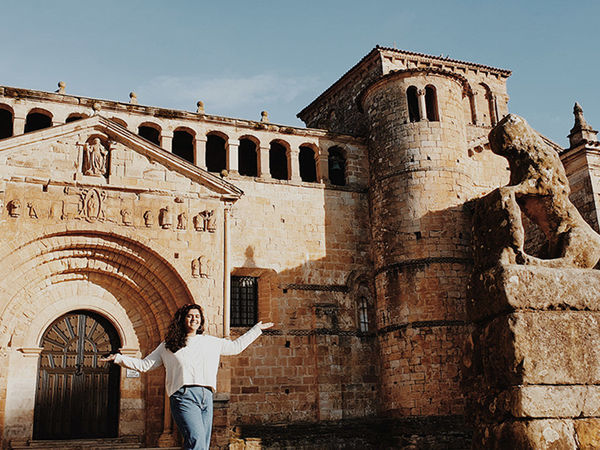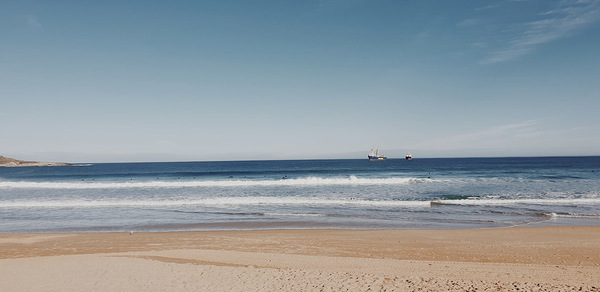
Natasha Ali MFA ’20, a recent graduate of Notre Dame's Graduate Creative Writing Program, used her Nanovic Academic Year Travel & Research Grant to conduct experiential research in Santander, Spain, which is where she set the novella that became her MFA thesis.
This article is part of a series of blog posts published by the Nanovic Institute for European Studies. The Nanovic Navigator is home to stories told by students about their unique experiences in Europe through Nanovic student grant programs. If you have questions about a story, a student, or the Nanovic Institute, please contact Anna Dolezal, student programs assistant manager (adolezal@nd.edu).
With my Academic Year Travel & Research Grant, I traveled to Santander, Spain, for a week and a half this January to work on my thesis—a novella-in-progress, also called “Santander.” The novella is set in and around that city, and the trip allowed me to amass notes and photographs that I would not have otherwise been able to collect.
The novella explores the question of what it means to have a body, with its own inner and outer worlds, and how navigating these worlds feels, particularly when that body is one that could be characterized as bad: an unwanted body, an unwelcome body, a wrong body. My novella’s protagonist, a student who has just relocated from her hometown of Karachi, Pakistan to the Spanish port city, is dealing with feelings of inadequacy and loneliness that can sometimes crop up when one is or feels like a stranger in a strange land. Having spent five months in 2018 working in a small village near Santander, I was already familiar with the region; yet I wanted to do those feelings justice and so focused my research accordingly. (You can, of course, feel lonely in the company of other people as well, but that is a different kind of loneliness and not one that I am interested in writing about here.)
The plot of the novella corresponds with one of the Nanovic Institute’s top research priorities, namely migration, integration, and the movement of people across borders. Santander follows the journey of a young Pakistani student who has recently moved from her hometown of Karachi to the Spanish port city of Santander to study at the prestigious Universidad de Cantabria, exploring themes of foreignness, identity, inheritance, insider vs. outsider status, one’s relationship with language, nationality, and nostalgia.
Having lived in Brussels, Belgium; Karachi, Pakistan; Riyadh, Saudi Arabia; St. Andrews, Scotland; Entrambasaguas, Spain; and the Midwestern United States, Michigan and now Indiana, I am fascinated by both the notion of belonging and its relation to that of diaspora and communities. The city of Santander provides me, as a writer, with an excellent stage on which to explore these ideas and issues that so intrigue me: a stage that is neither too large nor too small—and thus neither overwhelming nor suffocating—a stage that is different, and a stage that is colourful, too.
I spent the majority of my time in Spain visiting the myriad sites I mention my protagonist visiting in the novella: the Playa de Bikinis, a beach off Santander’s Magdalena Peninsula; King Döner, an Arab-Pakistani-Turkish restaurant in the heart of Santander; the sprawling Cabárceno Natural Park in the Valley of Pisueña; the historic village of Santillana del Mar; the cave of Las Monedas in Puente Viesgo; and El Sardinero in Santander, among others. I was able to add so much more colour—figuratively, in terms of descriptions; literally, in terms of photographs—to my novella by visiting these locations and exploring the region again through the mind of my protagonist.

I took note of all the things I had gotten wrong by using Google, and Google Maps in particular, as a reference point: the bookstore that was down a street instead of across from it; the dead giraffes and ruined enclosure replaced with live ones and an unspoiled one; the inaccurate articles I had ascribed place names (“Playa de Los Bikinis,” instead of “Playa de Bikinis,” etc.). I took numerous photographs as well: images that I will eventually thread through the text of the novella in a Sebaldian manner, to lend it heightened senses of depth and dimension and dynamism. I tracked when and where I felt most adrift, too, and tried to articulate why I felt the way that I did so that I could imbue my protagonist with heightened senses of depth and dimension and dynamism, too.
I remained conscious, at all times, of the fact that I was a person of colour in a racially homogenous region. I was surprised to find that I felt less isolated than I had thought I would, though, and I have begun to factor this realisation into my protagonist’s thought processes. (I think that I might have transposed sentiments from my experience of America onto this fictive experience of Spain.) I was able to speak with some Santander-based immigrants as well, and had some interesting conversations with them—particularly with a Kenyan woman who intimated that she and I were experiencing Santander entirely differently, because I could “pass” for a South American emigrant, the preferred sort of emigrant, as opposed to the detested sort: African, black and Maghrebi alike. (South Asian emigrants are, or seemed, at least, a rarity in Cantabria.) This is not something that I would have ever predicted or thought on my own.
When I was not outside, reconnoitering, I was inside, revising my old work and producing new work. My thesis already feels more meaningful, more robust than it had before I’d visited Santander—and I am grateful to the Nanovic Institute for providing me with the opportunity for such illuminating exploration.